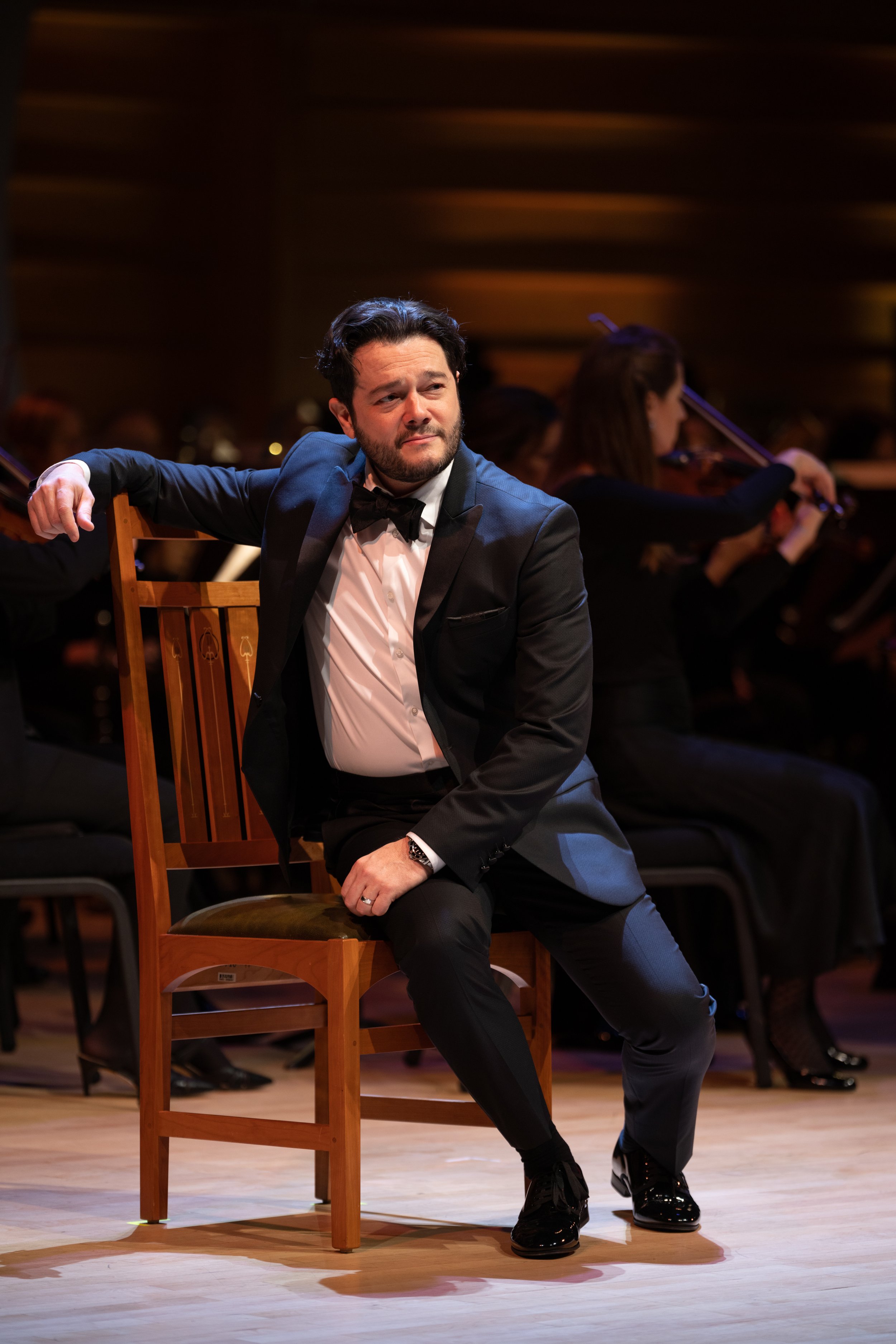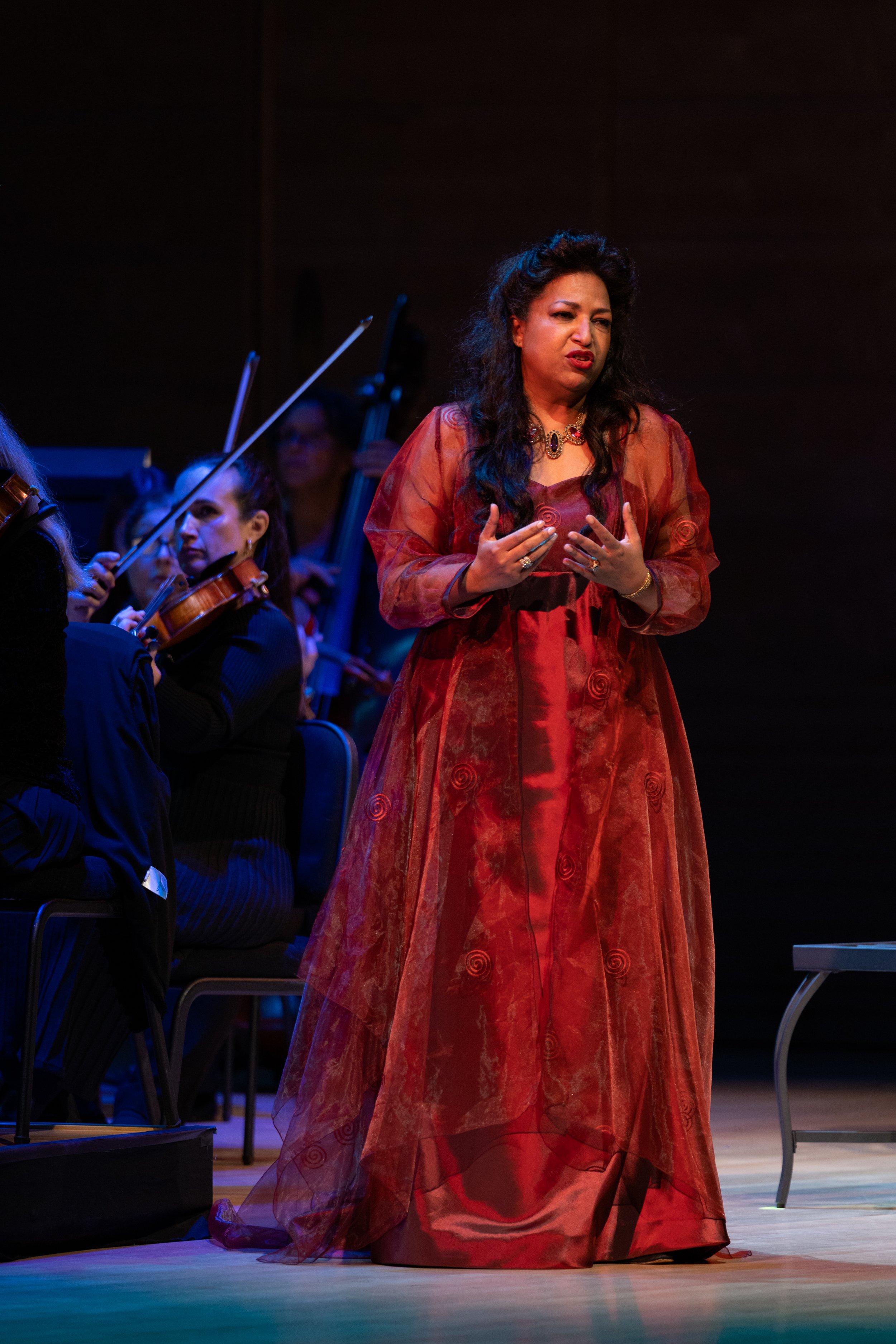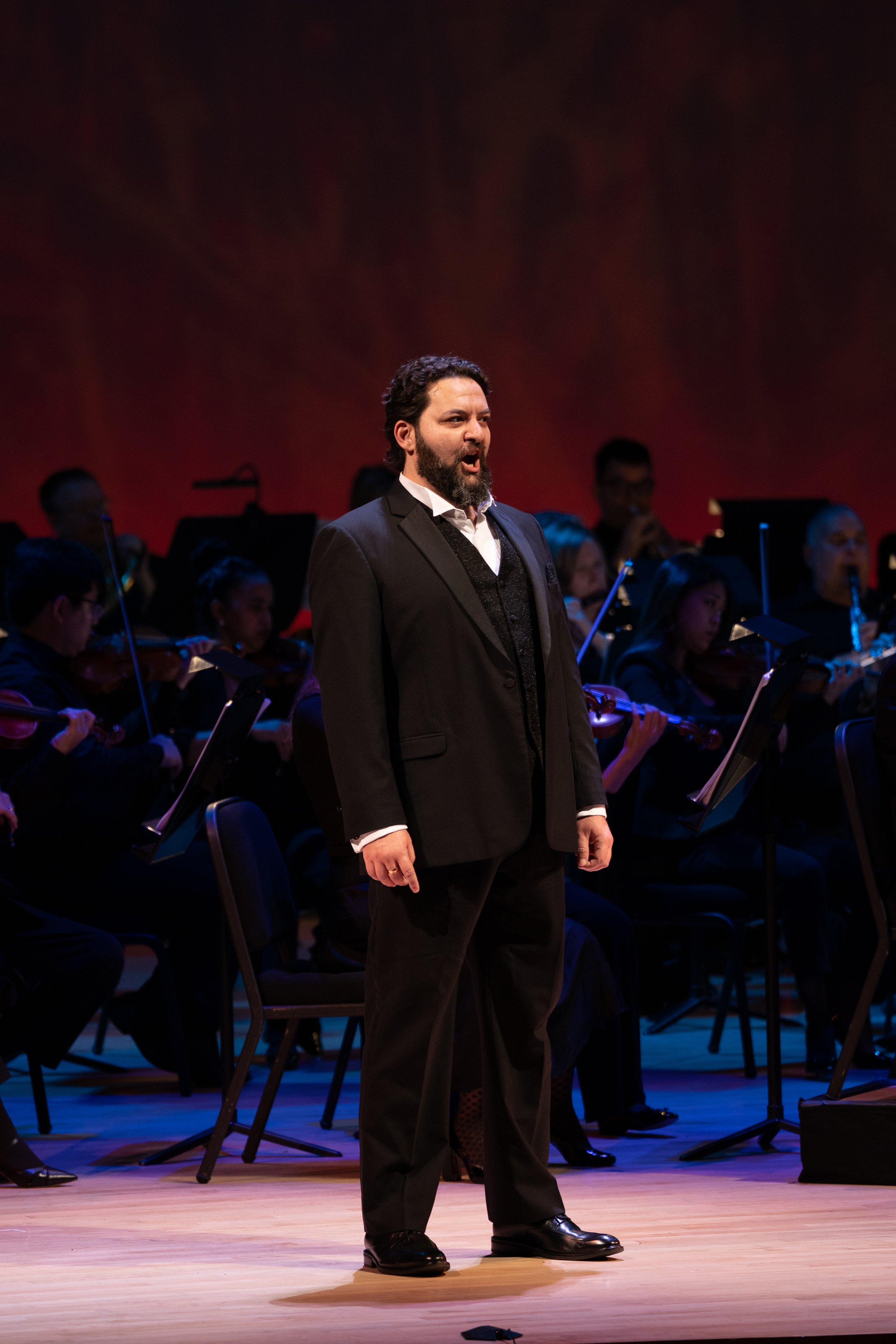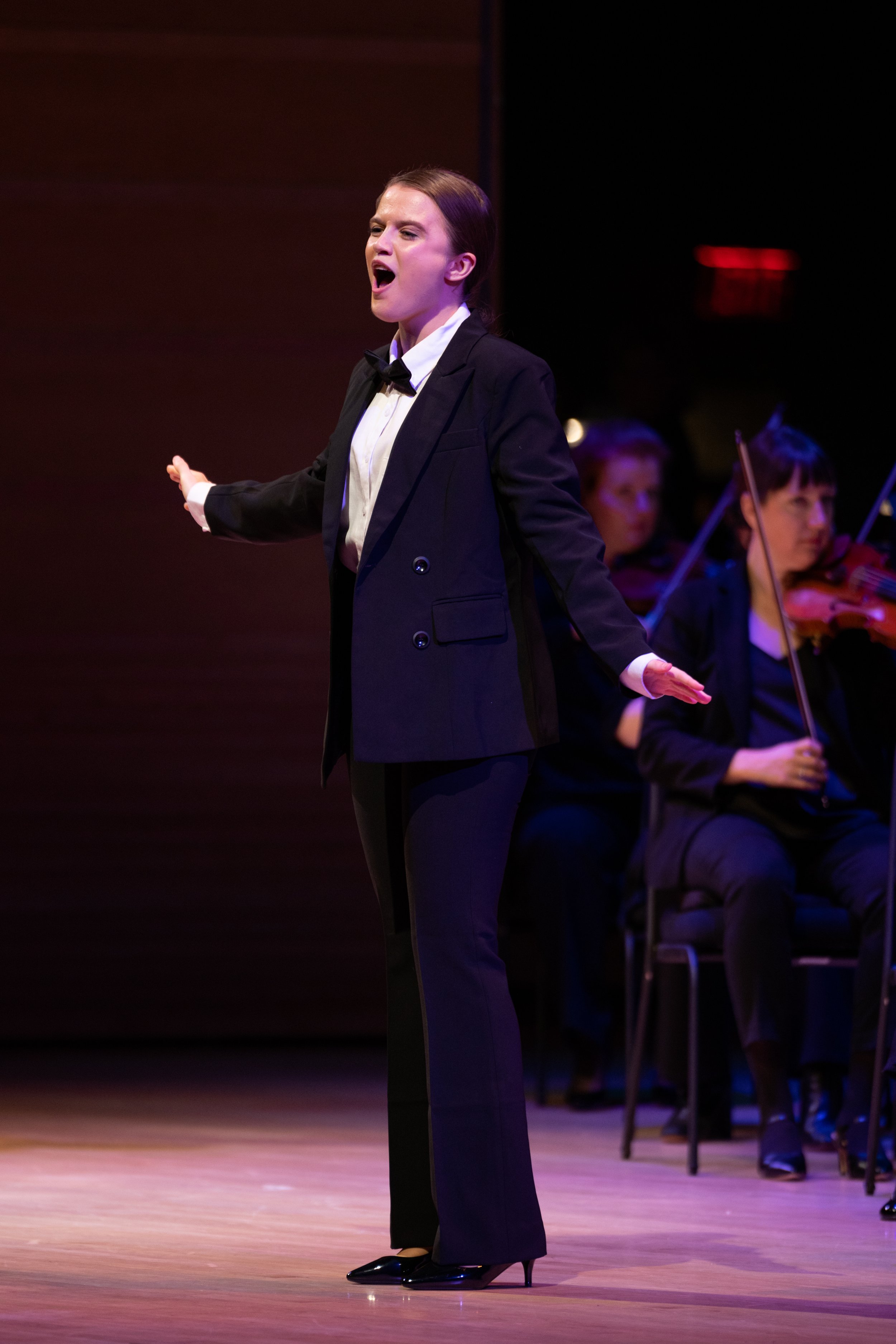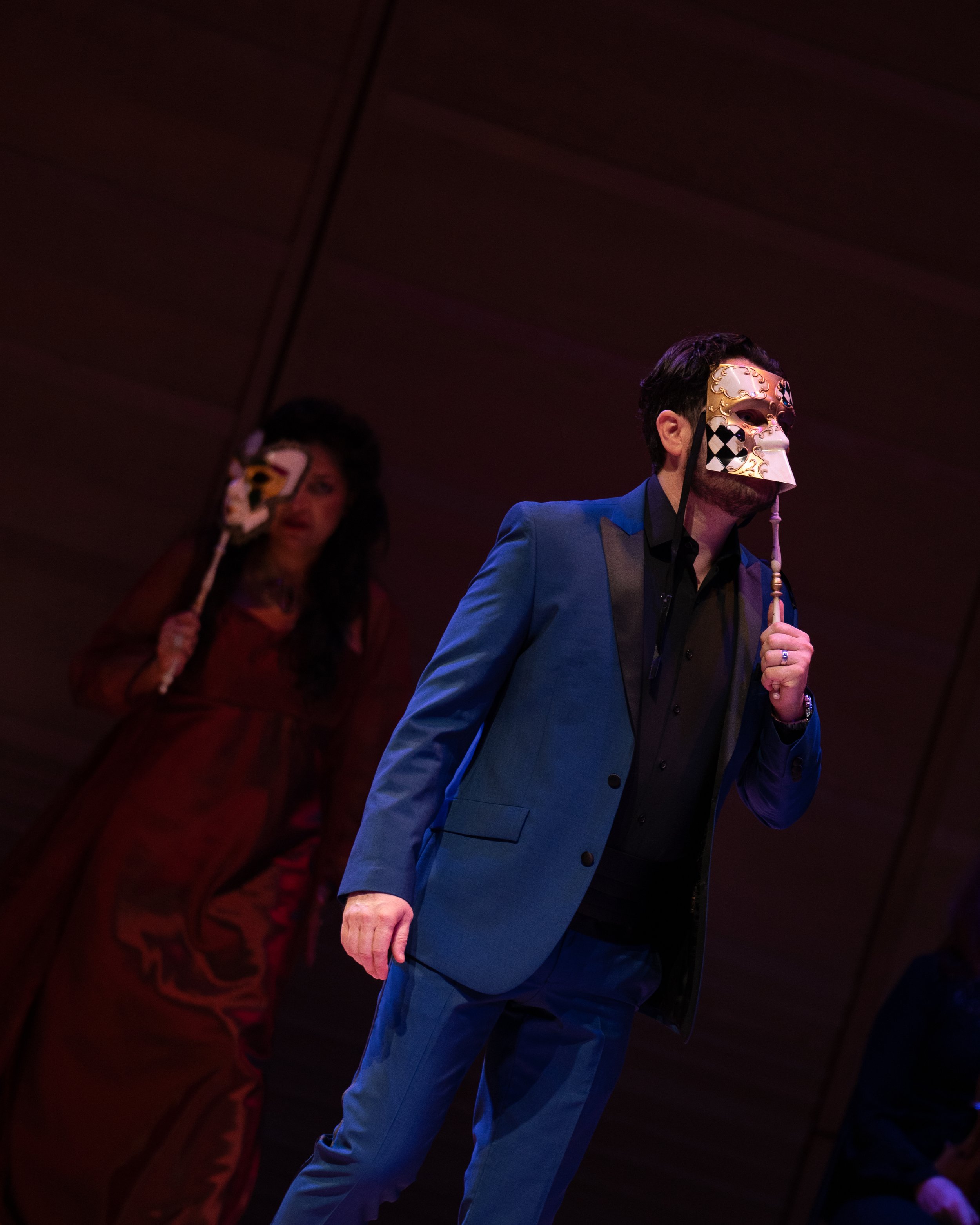Maryland Lyric Opera is having a season of Verdi. What a pleasure that the less often performed Un Ballo in Maschera (1859) was chosen for their next Verdi opera instead of the enormously popular La Traviata or Rigoletto or Aida. Of course, I would have attended any of those, but I had not seen Un Ballo before, and it speaks well of MDLO’s commitment to providing performances of a variety of classic operas to its community. In Verdi’s case, they have an array of operas to choose from. He wrote 28, and at least half remain in today’s opera repertoire. This one was Verdi’s 23rd, so an opera by a mature Verdi. MDLO opened their 2022-2023 season with his Macbeth back in September, and more Verdi operas are planned for the coming year, including Falstaff on January 20 and 22.
l to r: Aleksey Bogdanov as Renato, Indira Mahajan as Amelia, and Arturo Chacón-Cruz as Riccardo in Un Ballo in Maschera. Photo by Julian Thomas Photography; courtesy of Maryland Lyric Opera.
Giuseppe Verdi led an extraordinary life, and his Un Ballo in Maschera had a difficult path to the stage. Verdi was familiar with tragedy; in a span of two years his first wife and his two children died. He enjoyed enormous fame as perhaps the leading opera composer of his time, acquired substantial wealth, and became a popular figure in Italy’s Risorgimento, a movement to unify all of Italy. His Un Ballo was shaped (or perhaps ‘deformed’ is a better word) by censors. The libretto by Antonio Somma was based on a previous opera that dealt with the assassination of King Gustav III of Sweden. Censors found this too sensitive a topic for their day, with revolutions ongoing and other assassination attempts being made. Somma became so frustrated that he initially refused to allow his name on the final libretto. I gather that over the two years of development, the setting changed from Sweden to Poland and finally to Boston, with the opera’s name changing and the method by which the ruler is dispatched changing as transformations were required. Today, different versions are frequently performed. Since this was a concert version of Un Ballo, I can only say that it appeared that MDLO chose Boston and definitely had the Count shot.
Frankly, after reading a synopsis of the opera, my hopes for a great opera went down. The Count is under threat of assassination and is in love with Amelia who is married to his friend Renato who is his secretary. Amelia has also fallen in love with the Count but is pure-hearted and wants to expunge this love. They are both very adult about this, but Renato when he finds out is not. Ulrica, a gypsy woman fortune teller who worships Satan (Romani women stereotyped again), tells the Count he will be killed by the next person to shake his hand, and she tells Amelia to look in the graveyard by the gallows at night to find a plant that will cure her of this love; Riccardo overhears and plans to meet her to confront her with his love. Renato appears to warn Riccardo again about plots. He is instructed to escort the woman back to the city but not ask her anything; she has veiled her face, but the veil drops. It gets even more contrived. Yet…and yet, this cast and Verdi’s music made it work, turned the story into a gripping drama, and caused me to care about the characters. This achievement was made all the more amazing given that this was a partially staged, concert version of the opera without a set or period costumes. Conclusion: Verdi never lost his touch as a superior dramatist; he saw the possibilities to communicate the human condition that I did not. Bravi!
Arturo Chacón-Cruz as Riccardo and Indira Mahajan as Amelia. Photos by Julian Thomas Photography; courtesy of Maryland Lyric Opera.
A couple of interesting historical notes: the great American contralto, Marian Anderson, made her first and only appearance at the Metropolitan Opera in 1955 as the fortune teller Ulrica; she was the first black singer to appear at the Met (founded in 1883). And eerily, it is thought that the first opera attended by President Abraham Lincoln was Un Ballo; he attended a total of 30 before his assassination.
This talented and accomplished cast was simply fabulous acting and singing, making all the characters believably human. Mexican superstar tenor Arturo Chacón-Cruz played Riccardo with such warmth and tenderness that we loved him, even though he was so idealistic that he refused to take safeguards and then pardoned all who plotted against him. Mr. Chacón-Cruz has a beautifully burnished tenor voice and sang impressively all evening. International opera star and former Marian Anderson Award winner, soprano Indira Mahajan played Amelia. At first, I regretted she didn’t seem to want to show off her lovely voice with added trills and flourishes, but I was soon endeared with the emotionalism of her singing as she began to tear my heart out. Their duets and ensemble numbers also drew me into their characters. I thought baritone Aleksey Bogdanov as Renato sang brusquely in a low register in his initial vocals, but his voice mellowed out and was extraordinarily beautiful in his aria bemoaning his discovery of his wife’s affection for the Count.
Aleksey Bogdanov as Renato and Daryl Freedman as Ulrica. Photos by Julian Thomas Photography; courtesy of Maryland Lyric Opera.
Mezzo-soprano Daryl Freedman who played Ulrica is a graduate of the Cafritz Young Artists program of Washington National Opera. She has recently made a reputation for herself singing Wagner with the Virginia Opera and the Metropolitan Opera. This young singer has a voice that will immediately make you sit up and take notice, and Ulrica is a drama queen – a perfect match. Her acting and passionate singing breathed the necessary fire into Ulrica. Another scene stealer in the performance was Spanish soprano Aitana Sanz as Oscar, who is Riccardo’s page, a pants role; this was her American debut. This young soubrette had an ingratiating presence and sang beautifully; her aria defending the fortune teller was a delight. She seemed to play to the audience and the audience responded most favorably. Rounding out the cast effectively in supporting roles was bass-baritone Michael Pitocchi as Samuel, bass-baritone Adam Cioffari as Tom, baritone Javier Arrey as Silvano, and tenor Mauricio Miranda as a judge and servant.
left photo: Aitana Sanz as Oscar. right photo: Arturo Chacón-Cruz as Riccardo at the masked ball. Photos by Julian Thomas Photography; courtesy of Maryland Lyric Opera.
One of the stars of this performance was Verdi’s music. MDLO presents the music in Strathmore’s Music Center as well as you are likely to hear opera performed, by using a full orchestra on stage (75 members) and a full chorus (72 members) in the balconies around the stage. Both are typically excellent, providing a lush, sonic experience not often rivaled by opera house productions. The guest conductor for Un Ballo was Italian conductor Andrea Licata who has conducted in opera houses across the globe and is well known locally for many performances in Baltimore. I had the impression there was tight control between the music and the singers and Verdi’s music was delivered beautifully. A few times the softer voice singers had difficulty overcoming the volume of sound from the orchestra in this setting. The dramatic enhancement of the story telling by music in this production was striking. Gloriously melodic in nature, the music provided some lighter moments to the opera, contrasting with the words which I felt lacked amusement due to the ultimately dark nature of the plot. Husan Park who served as the conductor of the off stage banda also led the chorus as they gave an impressive performance. Truly, this cast and the music made magic happen in bringing the story to life.
The partial staging of this performance, directed by Visual Supervisor David Gately, was also a star of this production in a supporting role. The placement and movement added to the storytelling’s grip. The storytelling was also enhanced by stage lighting by Stuart Duke and image projections on a screen overhead by Sarah Tundermann. The images were selected from a deck of Tarot cards from 1909 intended to convey the power of fate and destiny on the characters. Different cards were used to represent a character’s motivations or traits in a scene. I thought the images helped add an unworldly atmosphere hovering over the action.
The Maryland Lyric Orchestra on stage and the Maryland Lyric Opera Chorus in the balconies behind with singers onstage including (l to r) Michael Pitocchi as Samuel, Adam Cioffari as Tom, Aleksey Bogdanov as Renato, Conductor Andrea Licata, Aitana Sanz as Oscar, Arturo Chacón-Cruz as Riccardo, and Daryl Freedman as Ulrica. Photo by Julian Thomas Photography; courtesy of Maryland Lyric Opera.
According to Merriam Webster, the second definition of “home run” is “an impressive success”. Yep, MDLO’s Un Ballo in Maschero was a home run. In fact, I am adding it to my top ten list of opera performances that I have seen, which includes at least one other MDLO production. Maryland Lyric Opera continues to bring world class classic opera to the Maryland suburban community.
The Fan Experience: Un Ballo in Maschera was performed on November 11 and 13 in the Strathmore Music Center. Stay tuned, MDLO will soon open ticketing for the performance of Verdi’s Falstaff on January 20 and 22. Mark your calendars.
The concert hall is a beautiful structure that has outstanding acoustics for concert performances. For those of us whose vision is not the best, having the images and the English subtitles on separate screens would be welcomed. Strathmore is conveniently located close to the Grosvenor Metro Stop on the Rockville Pike. Use of the parking deck is free on evenings and weekends. I have found parking there to be easy in and easy out. Cafeteria style food is offered again as pandemic restrictions have been limited, and there is a cash bar on lower level.
MDLO anticipates announcing the remainder of its “Season of Verdi” in the next couple of weeks; all operas are planned for performances at the Strathmore and will be concert presentations with full orchestra and chorus. Thanks to Maryland Lyric Opera patrons and contributors, tickets for any seat in the house will remain $10 for students with a student ID.


